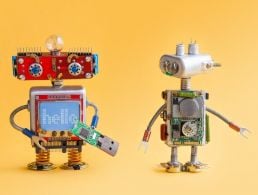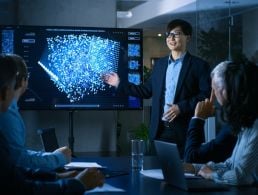Once heavily invested in the AI and machine learning systems that helped run the NASA Space Shuttle, Splice Machine CEO Monte Zweben is trying to overhaul the structure that lies at its very core.
Despite 2017 being described as the breakthrough year for machine learning and AI, the process by which computers learn complex skills and functions without human intervention is nothing new.
One person who can attest to that is Monte Zweben, CEO of Splice Machine, who in a previous life was the deputy branch chief of NASA Ames Research Center’s artificial intelligence (AI) hub.
Spending seven years there during the 1980s and 1990s, Zweben and the rest of his team were using machine learning, not only to discover cosmic phenomena through radio telescopes, but also to maintain and plan the famous space shuttle missions.
This, Zweben said in conversation with Siliconrepublic.com, laid the groundwork for his first major machine learning company, Blue Martini, founded in 1998.
Yet, as his company aims to build a hybrid machine learning infrastructure that would vastly improve on what is already out there, is there a fear that such systems – and AI in particular – will lead to a murky time in which humans in data science are left behind?
Monte Zweben, CEO at Splice Machine. Image: Splice Machine
Comparison with the steel industry
Rather than taking the Skynet approach and prophesying doomsday scenarios, Zweben thinks back to his days in university.
“I remember being an undergraduate in Pittsburgh many years ago at Carnegie Mellon during the time of the end of the steel industry [during the early 1980s],” he said.
“When I was a freshman, you could smell the steel mills, but by the time I left there were none operating.”
But, rather than that being the end of the city as people knew it, it ushered in a new era in a changing of the guards, of sort.
“It was an amazing transition that took place there, where industry and government helped the steelworker community and the city thrived, and now it’s a high tech city.
“You’re going to see the same thing happen in many different places around America, and it’s a matter of a transition, not a matter of some sort of dystopian universe.”
Industrial scene in Pittsburgh. Image: Wade H Massie/Shutterstock
IoT’s role in a future America
The same could be said about his particular background of data science and machine learning, which Zweben sees leading to the creation of new jobs, both direct and indirect.
“I think we’re seeing the next discontinuous leap in automation,” he said.
“I think there’s definitely opportunity for people to get new jobs. The whole notion of being a data scientist, and being able to convert data from raw signals that come from systems into something that might be useful for machine learning – those jobs never existed before.”
Interestingly, Zweben sees – at least within the US – the government playing a strong role in the likely transition process. It will see people finding themselves working, for instance, as technicians maintaining networks of internet of things (IoT) devices.
“There’ll be new jobs opening up; people will be trained accordingly. Then there obviously needs to be a safety net by government for those who get caught in the middle of this transition that may not be able to be retrained.
“Or maybe they need to be retrained in a way that industry wouldn’t pick up.”
AI and IoT are not Skynet
How this will play over the next four years – or eight – in a Republican administration under Donald Trump remains to be seen.
What is certain is that, based on the new president’s rhetoric, those same steel mills that Zweben remembers closing could be opening back up again.
Certainly, under Trump, the Department of Homeland Security will see the backing of a massive IoT sensor roll-out across the country, at least according to its deputy undersecretary for science and technology, Dr Bob Griffin.
Zweben references the need to maintain sensors in street lights, which could potentially be able to locate gunshots or crime in various areas and report those incidents to the local police force in a matter of seconds.
“[AI and IoT] are not Skynet, and what it is is just the next evolution in industrialisation as a society. At every level in history, when tech took a discontinuous leap there was a massive adjustment in the labour force.”
Streetlight sensors offer scope for massive retraining under IoT. Image: anuskiserrano/Shutterstock
Where does machine learning go from here?
So where does machine learning come into defining how our jobs – and data – are filtered in the years to come?
When big corporations are looking to use machine learning to solve complex problems, they tend to seek different requirements, whether transactional information or analytical capabilities.
The problem, Zweben said, is that this leads to a number of complex systems that don’t often communicate well with one another, and also take considerable time.
“Today, we see the need for a hybrid architecture,” he said.
“An architecture where somebody can run their applications on an extremely scalable platform in real-time and be able to monitor real-time customer interactions and other signals and devices in IoT.”
NASA crew working on space shuttle Discovery, one of the craft that Zweben and others helped maintain using AI. Image: NASA/Photo Carla Thomas
This has been the focus of Zweben’s Splice Machine venture. The company recently announced plans to release its open-source hybrid platform on Amazon Web Services – quite a long way from programming for NASA.
“I have a feeling that what we call IoT today – which is usually associated with physical devices – is going to become IoT that is being generated not just by physical devices, but by software itself,” Zweben added.
“I think we’ll start sending messages as if they were physical sensors to other servers.”
A far cry from working on code for the space shuttle, you’d have to say.




